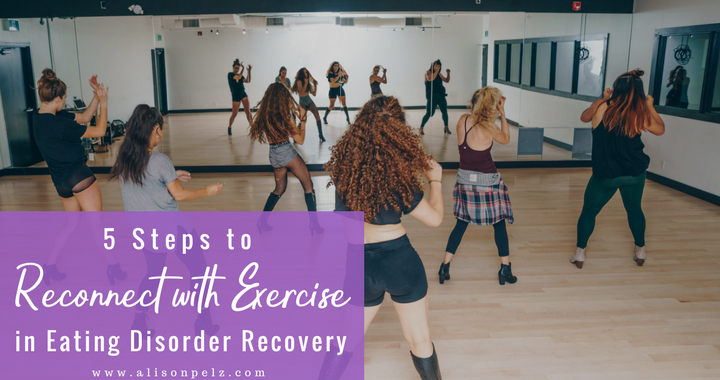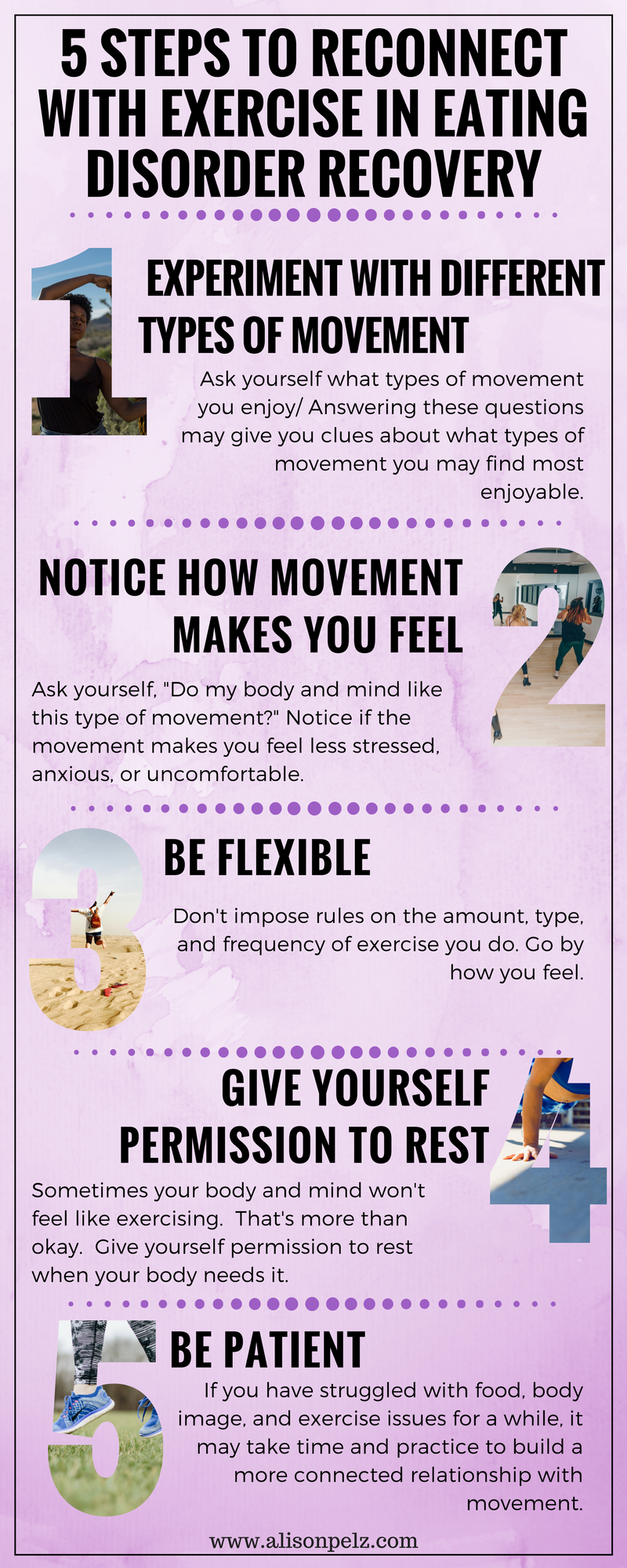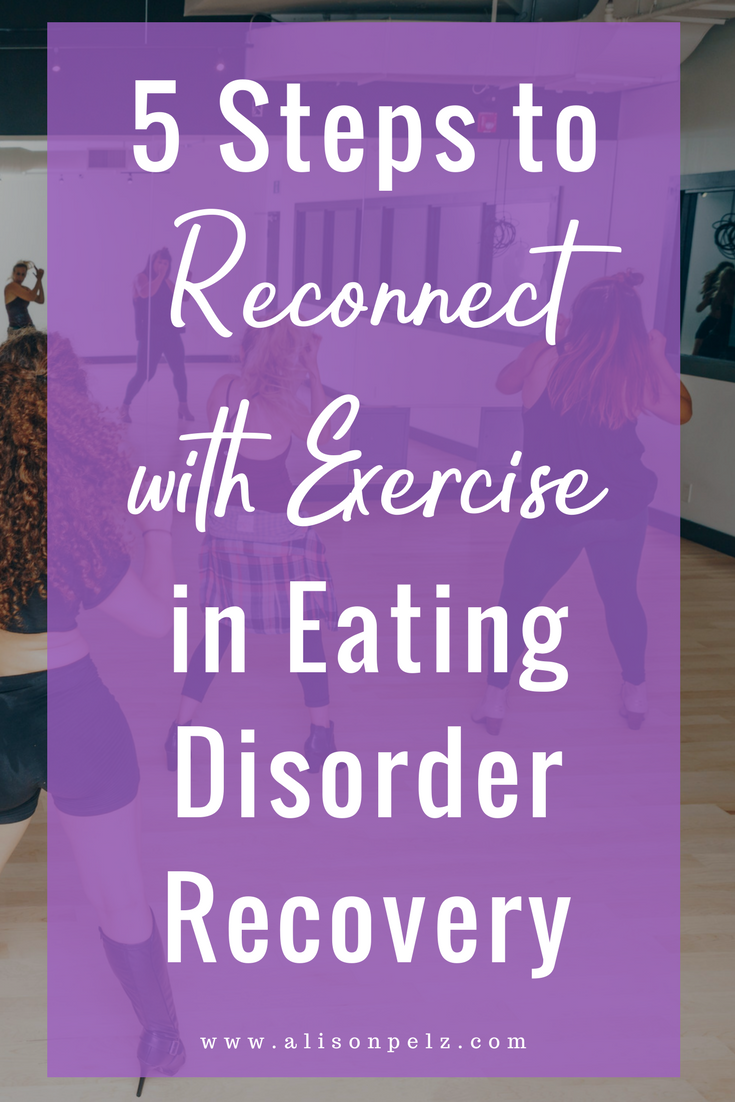If you have an eating disorder or have chronically dieted, your relationship with exercise may be complicated. Most folks would agree that exercise is a good thing, but in our thin-obsessed world, a well-intended trip to the gym can wreak havoc on one’s mental and physical health.
The following are warning signs that your relationship with exercise may be problematic:
1.Exercise is used exclusively to change your body weight or shape.
Exercise can start out harmless enough. Maybe you were working out to improve heart health or to be a better athlete. In any case, your intentions for exercise were good.
We are bombarded with messages about how, when, and why we should exercise. Exercise gurus are selling programs that try to guarantee we will look a certain way upon completion. With these types of messages, our relationship with exercise can start to change.
Exercise becomes more about how you look rather than the enjoyment of exercise itself. The truth is that body size and shape are determined mainly by genetics. Furthermore, our bodies are constantly changing because of the aging process.
2. Exercise is used to “make-up” for eating “mistakes”.
Many public health campaigns promote messages like “If you eat a donut it will take this many minutes of exercise to burn the donut off.” This line of thinking disconnects us from both the eating and the exercise experience.
It is hard to enjoy what you are eating if all you are thinking about is how many laps around the track you will need to run in order to compensate for it. These types of messages often lead to feelings of guilt if a workout is missed. They make us mindless, not mindful, eaters and exercisers.
The bottom line is: food is needed in order to survive. It is not a privilege earned.
3. Exercise is initiated when a new dieting or “lifestyle” is also started.
Contrary to popular belief, exercise is not an effective method for weight loss, but it is a positive influencer of health.
Many diets come along with a plan for movement. The problem is that once you go off the diet (which isn’t your fault, by the way, diets fail, not the people on them) then movement stops too. This leads to a habitual pattern of exclusively exercising when dieting, reinforcing the use of exercise to change the size or look of our bodies.
Unfortunately, many diet programs, so-called health experts, and public health campaigns promote these problematic thought patterns which can lead to the misuse of and disconnection from physical activity.
A troublesome relationship with exercise can lead to:
1.Over-exercising.
Over-exercising is often associated with eating disorders. It entails rigidity around movement (including intensity, type, and amount), exercising in order to give yourself permission to eat, and missing other obligations because of your exercise regimen. Over-exercising can lead heart problems, dehydration, stress fractures, loss of menstrual cycle in females, and muscular-skeletal problems.
2. Avoidance of exercise.
There are several reasons why you may not exercise. Trust me, if you have chronically dieted, laziness is not one of them.
Maybe you subscribe to the belief that movement dramatically changes your body size. However, studies show that exercise is not an effective weight loss method. Therefore, you may feel fed-up with exercise and stop as it fails to provide the intended weight loss.
Unfortunately, weight stigma is alive and well in our society. Weight stigma is associated with a decrease in exercise. So if you live in a larger body (vs. the culturally prescribed thin ideal), most likely you have experienced weight stigma.
Being physically uncomfortable, not feeling like you are good at exercise, or having had a traumatic experience around exercise are frequent reasons why people avoid exercise.
Whether you avoid exercise, over-exercise, or fall somewhere in between there are things that you can do to improve your relationship with exercise.
Before starting an exercise routine make sure that you have had a physical exam. If you are in treatment for an eating disorder talk with your treatment team first before starting exercise. If you have experienced trauma, bullying, or humiliation around physical activity it may be helpful to explore past experiences with a therapist.
I love to use the word “reconnect” when talking about exercise. In the same way dieting or an eating disorder disconnects us from our experience with food, rigid exercise patterns or avoidance of movement also disconnects us from the possible joy and benefits of physical activity.
Tips to reconnect with exercise:
- Experiment with different types of movement. Ask yourself: Do I like to be outside? Are classes something I enjoy? Do I like to sweat? Is listening to music something I enjoy? Do I like to be social during movement? Do I like to play sports instead of going to the gym or hiking? Answering these questions may give you clues about what types of movement you may find most enjoyable.
- Notice how movement makes you feel. Ask yourself, “Do my body and mind like this type of movement?” Different types of movement may feel different to different people. Notice if the movement makes you feel less stressed, anxious, or uncomfortable.
- Be flexible. Don’t impose rules on the amount, type, and frequency of exercise you do. Go by how you feel. For example, if you have been sitting all day it may feel good to get up and do some movement. If you have been on your feet all day, it may feel better to do some gentle stretching or to put your feet up and relax.
- Give yourself permission to rest. Sometimes your body and mind won’t feel like exercising. That’s more than okay. Give yourself permission to rest when your body needs it.
- Be patient. If you have struggled with food, body image, and exercise issues for a while, it may take time and practice to build a more connected relationship with movement.
The bottom line is that through listening to your body, patience, and practice you can find the type of movement that is right for you to promote both your mental and physical health.
Would you like to receive helpful tips for eating disorder or diet recovery? Click here!


